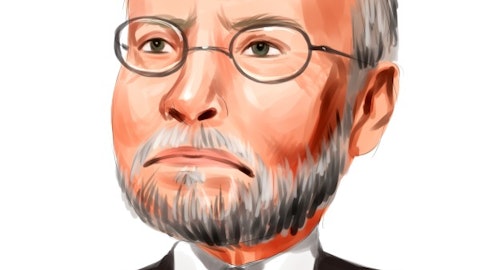“We first invested in Allergan (through its predecessor Actavis) in November 2013. Since then, we have watched the company increase per share value through three transformative transactions: the acquisition of Forest Laboratories Inc. (announced February 2014), the acquisition of Allergan, Inc. (announced November 2014), and in July, the announced sale of its generics franchise to Teva Pharmaceutical Industries, Ltd. (TEVA), which we expect to close in the first quarter of 2016. When the TEVA transaction closes, the new Allergan will be a branded pharmaceutical company with six key therapeutic areas and $15 billion of revenues, expected to grow its top line at low double digits and earnings per share at 20 percent per annum. It will also have close to zero net leverage when adjusted for the proceeds from TEVA. The AGN of tomorrow looks nothing like the small generic company of Watson Pharmaceuticals Inc. that Paul Bisaro took the helm of in 2007. Importantly, it also looks nothing like certain of its specialty pharma peers, which have been tarnished by the cascade of bad news and government inquiries into aggressive business practices. We recognized this distinction and swapped our Valeant position into an increased Allergan stake in September. We think it is important for our investors to note that though certain specialty pharma names (Allergan, Endo International PLC (ENDP) and Valeant) have become popular longs across many managers (2), we are not Johnny-come-latelies to this group and have developed a nuanced understanding of the key distinctions among their assets, their business strategies and their management teams. Our buy and sell discipline in all or the positions we have transacted in has been quite good. We owned Mallinckrodt PLC (MNK) from June 2013 through August 2014; we exited at the time of the Questcor Pharmaceuticals Inc. acquisition announcement because we believed Questcor was a low quality asset. We owned Endo from September 2013 through August 2014; we exited when the multiple had expanded from roughly 11x earnings at our cost to roughly 15x – at the time a premium to the peers. We owned Valeant from September 2014 through September 2015, acquiring the stock at about 11x earnings and having sold much of the position to respect its expanded multiple before the September drawdown — and all of it before the October collapse. At the time or this writing, Allergan is the only of these companies trading above its “pre-Hillary tweet” September levels as the stock price has moved to reflect news of Pfizer Inc.’s (PFE) potential interest in Allergan – interest that we believe confirms the quality of Allergan’s assets, management and business practices.”
How are hedge funds trading Allergan, Inc. (NYSE:AGN)?
Heading into 2016, a total of 159 of the hedge funds tracked by Insider Monkey were bullish on this stock, a change of 5% from the previous quarter. With hedge funds’ positions undergoing their usual ebb and flow, there exists an “upper tier” of key hedge fund managers who were upping their holdings significantly (or already accumulated large positions).
According to Insider Monkey’s hedge fund database, Andreas Halvorsen’s Viking Global has the largest position in Allergan, Inc. (NYSE:AGN), worth close to $1.87 billion, comprising 7% of its total 13F portfolio. Sitting at the No. 2 spot is Paulson & Co, managed by John Paulson, which holds a $1.73 billion position; 10.3% of its 13F portfolio is allocated to the stock. Other members of the smart money with similar optimism encompass Dan Loeb’s Third Point, Matthew Halbower’s Pentwater Capital Management and Paul Singer’s Elliott Management.
As industrywide interest jumped, specific money managers have jumped into Allergan, Inc. (NYSE:AGN) headfirst. Pentwater Capital Management, managed by Matthew Halbower, initiated the most valuable call position in Allergan, Inc. (NYSE:AGN). Pentwater Capital Management had $466.2 million invested in the company at the end of the quarter. Zach Schreiber’s Point State Capital also made a $326.1 million investment in the stock during the quarter. The other funds with new positions in the stock are Eric Mindich’s Eton Park Capital, Paul Singer’s Elliott Management, and John Overdeck and David Siegel’s Two Sigma Advisors.
Let’s check out hedge fund activity in other stocks – not necessarily in the same industry as Allergan, Inc. (NYSE:AGN) but similarly valued. We will take a look at Unilever plc (ADR) (NYSE:UL), Amgen, Inc. (NASDAQ:AMGN), PetroChina Company Limited (ADR) (NYSE:PTR), and Taiwan Semiconductor Mfg. Co. Ltd. (ADR) (NYSE:TSM). This group of stocks’ market valuations are closest to AGN’s market valuation.
| Ticker | No of HFs with positions | Total Value of HF Positions (x1000) | Change in HF Position |
|---|---|---|---|
| UL | 11 | 335611 | -2 |
| AMGN | 68 | 4686118 | -5 |
| PTR | 8 | 24412 | -2 |
| TSM | 24 | 1785238 | -8 |
As you can see these stocks had an average of 27.75 hedge funds with bullish positions and the average amount invested in these stocks was $1.7 billion. That figure was $22.2 billion in AGN’s case. Amgen, Inc. (NASDAQ:AMGN) is the most popular stock in this table. On the other hand PetroChina Company Limited (ADR) (NYSE:PTR) is the least popular one with only 8 bullish hedge fund positions. Compared to these stocks Allergan, Inc. (NYSE:AGN) is decisively more popular among hedge funds. Considering that hedge funds are fond of this stock in relation to its market cap peers, it may be a good idea to analyze it in detail and potentially include it in your portfolio.





